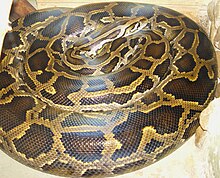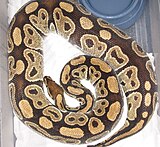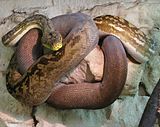Python (genus)
| Python | |
|---|---|

| |
| Burmese python (Python bivittatus) | |
| Scientific classification | |
| Domain: | Eukaryota |
| Kingdom: | Animalia |
| Phylum: | Chordata |
| Class: | Reptilia |
| Order: | Squamata |
| Suborder: | Serpentes |
| Family: | Pythonidae |
| Genus: | Python Daudin, 1803 |
| Synonyms | |
|
List
| |
Python is a genus of constricting snakes in the Pythonidae family native to the tropics and subtropics of the Eastern Hemisphere.[1] Currently, 10 python species are recognized.[2]
The word 'python' is derived from Latin meaning 'serpent'.[3]
Until recently, seven extant species were recognised; however, three subspecies have been promoted and a new species recognised. A member of this genus, P. reticulatus, is among the longest snake species and extant reptiles in the world.
Distribution and habitat

In Africa, pythons are native to the tropics south of the Sahara, but not in the extreme south-western tip of southern Africa (Western Cape) or in Madagascar. In Asia, they occur from Bangladesh, Nepal, India, Pakistan, and Sri Lanka, including the Nicobar Islands, through Myanmar, east to Indochina, southern China, Hong Kong and Hainan, as well as in the Malayan region of Indonesia and the Philippines.[1]
Invasive
Some suggest that P. molurus and P. sebae have the potential to be problematic invasive species in South Florida.[4] The United States Department of Agriculture reports that only Python bivittatus is an invasive species in the United States.[5] In early 2016, after a culling operation yielded 106 pythons, Everglades National Park officials suggested that "thousands" may live within the park, and that the species has been breeding there for some years. More recent data suggest that these pythons would not withstand winter climates north of Florida, contradicting previous research suggesting a more significant geographic potential range.[6]
Taxonomy
The generic name Python was proposed by François Marie Daudin in 1803.[7]
The following species were proposed:
| Species | Image | IUCN Red List and geographic range |
|---|---|---|
| Python molurus (Linnaeus, 1758)[8] – Indian rock python | 
|
NE Pakistan, India, Sri Lanka, southern Nepal, Bangladesh, Myanmar. |
| Python sebae (Gmelin, 1788)[9] – African rock python P. s. natalensis (Smith, 1840) |

|
NE Africa south of the Sahara from Senegal to Ethiopia and Somalia, including Guinea-Bissau, Mali, Guinea, Sierra Leone, Liberia, Ivory Coast, Burkina Faso, Ghana, Togo, Niger, Nigeria, Cameroon, Equatorial Guinea, Chad, Central African Republic, Democratic Republic of the Congo, Rwanda, Burundi, Sudan, Uganda, Kenya, and Tanzania, Southern Africa, such as Democratic Republic of the Congo, Rwanda, Burundi, Kenya, Tanzania, Angola, Zambia, Malawi, Namibia, Zimbabwe, Botswana, Mozambique, Swaziland, Lesotho, and South Africa.[1] |
| Python reticulatus (Schneider, 1801)[10] – Reticulated python | 
|
LC[11] Southeast Asia from the Nicobar Islands, Myanmar, Thailand, Laos and Cambodia, Vietnam, Malaysia, east through Indonesia and the Indo-Australian Archipelago (Sumatra, Mentawai Islands, Natuna Islands, Borneo, Sulawesi, Java, Lombok, Sumbawa, Sumba, Flores, Timor, Maluku and Tanimbar Islands), Philippines (Basilan, Bohol, Cebu, Leyte, Luzon, Mindanao, Mindoro, Negros, Palawan, Panay, Polillo, Samar, Tawi-Tawi).[11] |
| Python regius (Shaw, 1802)[12] – Ball python | 
|
LC[13] Africa from Senegal, Mali, Guinea-Bissau, Guinea, Sierra Leone, Liberia, Ivory Coast, Ghana, Benin, Niger and Nigeria through Cameroon, Chad and the Central African Republic to Sudan and Uganda. |
| Python bivittatus (Kuhl, 1820)[14] – Burmese python | 
|
VU[15] From southern Nepal, India, Bangladesh, Myanmar, Thailand, Laos, Cambodia, Vietnam to northern Malaysia, southern China including Yunnan east to Fujian, Hainan and Hong Kong, Sichuan, Guangxi, Guangdong, and the Indonesian islands of Java and Bali.[15] |
| Python curtus (Schlegel, 1872)[16] – Sumatran short-tailed python | 
|
LC[17] Southeast Asia in southern Thailand, Malaysia (Peninsular and Sarawak) (including Pinang) and Indonesia (Sumatra, Riau Archipelago, Lingga Islands, Bangka Islands, Mentawai Islands and Kalimantan).[17] |
| Python timoriensis (Peters, 1876)[18] – Timor python | 
|
NE Indonesia on the Lesser Sunda Islands (Flores, Lombien and Timor Islands).[1] |
| Python breitensteini (Steindachner, 1881) – Borneo short-tailed python (formerly P. curtus breitensteini) | 
|
LC[19] |
| Python anchietae (Bocage, 1887) – Angolan python | 
|
LC[20] |
| Python brongersmai (Stull, 1938) (formerly P. curtus brongersmai) – Brongersma's short-tailed python | 
|
LC[21] Peninsular Malaysia, Sumatra, Bangka Island, Lingga islands, Riau islands, and Pinang[21] |
| Python kyaiktiyo (Zug, Gotte & Jacobs, 2011) [22] – Myanmar short-tailed python | 
|
VU[23] West of the Tenghyo Range, Myanmar[23] |
| Python europaeus (Szyndlar & Rage, 2003)[24] | EX Extinct species from the Miocene era, described on basis of vertebrae found in Vieux-Collonges and La Grive in France.[24] |
Uses

Python skin is used to make clothing, such as vests, belts, boots and shoes, or fashion accessories such as handbags. It may also be stretched and formed as the sound board of some string musical instruments, such as the erhu spike-fiddle, sanxian and the sanshin lutes.[25][26]
As pets
Many Python species, such as P. regius, P. brongersmai, P. bivittatus and P. reticulatus, are popular to keep as pets due to their ease of care, docile temperament, and vibrant colors, with some rare mutations having been sold for several thousands of dollars. Despite controversy that has arisen from media reports, with proper safety procedures pet pythons are relatively safe to own,[27] and deaths associated with them are isolated compared to other domestic animals, such as dogs and horses.[26][28]
See also
References
- ^ a b c d McDiarmid, R. W.; Campbell, J. A.; Touré, T. (1999). "Python". Snake Species of the World: A Taxonomic and Geographic Reference. Volume 1. Washington, DC: Herpetologists' League. ISBN 1893777014.
{{cite book}}: Cite has empty unknown parameter:|chapterurl=(help) - ^ Barker, D. G.; Barker, T. M.; Davis, M. A.; Schuett, G. W. (2015). "A review of the systematics and taxonomy of Pythonidae: an ancient serpent lineage" (PDF). Zoological Journal of the Linnean Society. 175 (1): 1−19. doi:10.1111/zoj.12267.
- ^ Lewis, C. T.; Short, C. (1879). "Python". A Latin Dictionary. Oxford: Clarendon Press.
{{cite book}}: External link in|chapterurl=|chapterurl=ignored (|chapter-url=suggested) (help) - ^ "Python Snakes, An Invasive Species In Florida, Could Spread To One Third Of US". ScienceDaily. 2008. Retrieved 2017-08-01.
- ^ Invasive Species: Animals. Invasivespeciesinfo.gov. Retrieved on 2013-07-17.
- ^ Avery, M. L.; Engeman, R. M.; Keacher, K. L.; Humphrey, J. S.; Bruce, W. E.; Mathies, T. C.; Mauldin, R. E. (2010). "Cold weather and the potential range of invasive Burmese pythons". Biological Invasions. 12 (11): 3649−3652.
- ^ Daudin, F. M. (1803). "Python". Histoire naturelle, générale et particulière, des reptiles. Tome 8. Paris: De l'Imprimerie de F. Dufart. p. 384.
{{cite book}}: External link in|chapterurl=|chapterurl=ignored (|chapter-url=suggested) (help) - ^ Linnaeus, C. (1758). "Coluber molurus". Systema naturae per regna tria naturae: secundum classes, ordines, genera, species, cum characteribus, differentiis, synonymis, locis. Vol. 1 (Tenth reformed ed.). Holmiae: Laurentii Salvii. p. 225.
{{cite book}}: External link in|chapterurl=|chapterurl=ignored (|chapter-url=suggested) (help) - ^ Gmelin, J. F. (1788). "Coluber sebae". Caroli a Linné. Systema naturae per regna tria naturae: secundum classes, ordines, genera, species, cum characteribus, differentiis, synonymis, locis. Vol. I, Part III (13., aucta, reformata ed.). Lipsiae: Georg Emanuel Beer. p. 1118.
{{cite book}}: External link in|chapterurl=|chapterurl=ignored (|chapter-url=suggested) (help) - ^ Schneider, J. G. (1801). "Boa Reticulata". Historiae Amphibiorum naturalis et literariae Fasciculus Secundus continens Crocodilos, Scincos, Chamaesauras, Boas, Pseudoboas, Elapes, Angues, Amphisbaenas et Caecilias. Jenae: Wesselhoeft. pp. 264−266.
{{cite book}}: External link in|chapterurl=|chapterurl=ignored (|chapter-url=suggested) (help) - ^ a b Stuart, B.; Thy, N.; Chan-Ard, T.; Nguyen, T. Q.; Grismer, L.; Auliya, M.; Das, I.; Wogan, G. (2018). "Python reticulatus". The IUCN Red List of Threatened Species. 2018. IUCN: e.T183151A1730027. doi:10.2305/IUCN.UK.2018-2.RLTS.T183151A1730027.en.
- ^ Shaw, G. (1802). "Boa regia". General zoology, or Systematic natural history. Volume III, Part II. London: G. Kearsley. pp. 347–348.
{{cite book}}: External link in|chapterurl=|chapterurl=ignored (|chapter-url=suggested) (help) - ^ Auliya, M.; Schmitz, A. (2010). "Python regius". The IUCN Red List of Threatened Species. 2010. IUCN: e.T177562A7457411. doi:10.2305/IUCN.UK.2010-4.RLTS.T177562A7457411.en. Retrieved 13 March 2018.
- ^ Kuhl, H. (1820). "Python bivittatus mihi". Beiträge zur Zoologie und vergleichenden Anatomie. Frankfurt am Main: Verlag der Hermannschen Buchhandlung. p. 94.
{{cite book}}: External link in|chapterurl=|chapterurl=ignored (|chapter-url=suggested) (help) - ^ a b Stuart, B.; Nguyen, T. Q.; Thy, N.; Grismer, L.; Chan-Ard, T.; Iskandar, D.; Golynsky, E.; Lau, M. W. N. (2012). "Python bivittatus". The IUCN Red List of Threatened Species. 2012: e.T193451A2237271. doi:10.2305/IUCN.UK.2012-1.RLTS.T193451A2237271.en. Retrieved 13 March 2018.
{{cite journal}}: Unknown parameter|last-author-amp=ignored (|name-list-style=suggested) (help) - ^ Schlegel, H. (1872). "De Pythons". In Witkamp, P. H. (ed.). De Diergaarde van het Koninklijk Zoölogisch Genootschap Natura Artis Magistra te Amsterdam: De Kruipende Dieren. Amsterdam: Van Es. pp. 53–54.
{{cite book}}: External link in|chapterurl=|chapterurl=ignored (|chapter-url=suggested) (help) - ^ a b Inger, R. F.; Iskandar, D.; Lilley, R.; Jenkins, H.; Das, I. (2014). "Python curtus". The IUCN Red List of Threatened Species. 2014. IUCN: e.T192244A2060581. doi:10.2305/IUCN.UK.2014-1.RLTS.T192244A2060581.en. Retrieved 13 March 2018.
- ^ Peters (1876). "Serpentes". Monatsberichte der Königlichen Preussische Akademie des Wissenschaften zu Berlin (August): 533–534.
- ^ a b Inger, R. F.; Iskandar, D.; Lilley, R.; Jenkins, H.; Das, I. (2012). "Python breitensteini". IUCN Red List of Threatened Species. 2012: e.T192013A2028005. doi:10.2305/IUCN.UK.2012-1.RLTS.T192013A2028005.en. Retrieved 13 March 2018.
- ^ a b Auliya, M. (2010). "Python anchietae". The IUCN Red List of Threatened Species. 2010. IUCN: e.T177539A7452448. doi:10.2305/IUCN.UK.2010-4.RLTS.T177539A7452448.en. Retrieved 13 March 2018.
- ^ a b Grismer, L.; Chan-Ard, T. (2012). "Python brongersmai". The IUCN Red List of Threatened Species. 2012. IUCN: e.T192169A2050353. doi:10.2305/IUCN.UK.2012-1.RLTS.T192169A2050353.en. Retrieved 13 March 2018.
- ^ Zug, G. R.; Gotte, S. W.; Jacobs, J. F. (2011). "Pythons in Burma: Short-tailed python (Reptilia: Squamata)" (PDF). Proceedings of the Biological Society of Washington. 124 (2): 112−136. doi:10.2988/10-34.1.
- ^ a b Wogan, G.; Chan-Ard, T. (2012). "Python kyaiktiyo". The IUCN Red List of Threatened Species. 2012. IUCN: e.T199854A2614411. doi:10.2305/IUCN.UK.2012-1.RLTS.T199854A2614411.en. Retrieved 13 March 2018.
- ^ a b Szyndlar, Z.; Rage, J. C. (2003). "Python europaeus". Non-erycine Booidea from the Oligocene and Miocene of Europe. Kraków: Institute of Systematics and Evolution of Animals. pp. 68−72.
- ^ http://erhuworld.com/
- ^ a b http://www.asovivasanshin.com/introduction.html
- ^ "Playing with the Big Boys: Handling Large Constrictors". www.anapsid.org. Retrieved 2017-08-01.
- ^ "Untitled Document". www.anapsid.org. Retrieved 2017-08-01.
External links
- Python at the Reptarium.cz Reptile Database. Accessed 11 September 2007.
